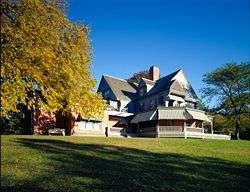Sagamore Hill (house)
|
Sagamore Hill National Historic Site | |
|
Sagamore Hill | |
  | |
| Location | Cove Neck, New York |
|---|---|
| Coordinates | 40°53′8″N 73°29′51″W / 40.88556°N 73.49750°WCoordinates: 40°53′8″N 73°29′51″W / 40.88556°N 73.49750°W |
| Area | 83.02 acres (33.60 ha) |
| Built | 1884 |
| Architect | Lamb & Rich; C. Grant LaForge |
| Architectural style | Queen Anne |
| Visitation | 38,009 (2005) |
| Website | Sagamore Hill National Historic Site |
| NRHP Reference # | 66000096 |
| Significant dates | |
| Added to NRHP | October 15, 1966[1] |
| Designated NHS | July 25, 1962 |
Sagamore Hill was the home of the 26th President of the United States, Theodore Roosevelt, from 1885 until his death in 1919. It is located in the Incorporated Village of Cove Neck, New York, near Oyster Bay on the North Shore of Nassau County in Long Island,[2] 25 miles (40 km) east of Manhattan. It is now the Sagamore Hill National Historic Site, which includes the Theodore Roosevelt Museum in a later building on the grounds.
History
Although a native of New York City, Theodore Roosevelt spent many summers of his youth on extended vacations with his family in the Oyster Bay area. In 1880, by then a young adult of 22, Roosevelt purchased 155 acres (63 ha) of land for $30,000 (equal to about $700,000 today) on Cove Neck, a small peninsula roughly 2 miles (3.2 km) northeast of the Village of Oyster Bay. In 1881, his uncle James A. Roosevelt had designed his estate home several hundred feet west of the Sagamore Hill property. In 1884 Theodore Roosevelt hired the New York architectural firm Lamb & Rich to design a shingle-style, Queen Anne home for the property. The twenty-two room home was completed in 1886 for $16,975 (equal to $447,826 today), and Roosevelt moved into the house in 1887. Roosevelt originally planned to name the house "Leeholm" after his wife Alice Hathaway Lee Roosevelt. However, she died in 1884 and Roosevelt remarried in 1886, so he decided to change the name to "Sagamore Hill". Sagamore is the Algonquin word for chieftain, the head of the tribe. In 1905 Roosevelt decided to expand the house, adding the largest room, called the "North Room" (40 by 30 feet (12.2 by 9.1 m)), for $19,000 (equal to $501,248 today). The home now has twenty-three rooms.
The house and its surrounding farmland became the primary residence of Theodore and Edith Roosevelt for the rest of their lives. Sagamore Hill took on its greatest importance when it became known as the "Summer White House" during the seven summers (1902–1908) Roosevelt spent there as President. Roosevelt died at Sagamore Hill in January 1919.
On July 25, 1962, Congress established Sagamore Hill National Historic Site to preserve the house as a unit of the National Park Service. As with all historic areas administered by the National Park Service, Sagamore Hill was listed on the National Register of Historic Places on October 15, 1966.[3] The home is open to the public by guided tour. Almost all the furnishings are original. Also on the site is the Theodore Roosevelt Museum, which chronicles the life and career of the President. The museum is housed in the 1938 house called "Old Orchard", the former residence of Brigadier General Theodore Roosevelt Jr. and his family.
References
- ↑ National Park Service (2008-04-15). "National Register Information System". National Register of Historic Places. National Park Service.
- ↑ Bleyer, Bill. When LI place names don't reflect the map. Newsday. Accessed on October 9, 2007.
- ↑ National Register of Historic Places, listed October 15, 1966.
- The National Parks: Index 2001–2003. Washington: U.S. Department of the Interior.
External links
 Media related to Sagamore Hill at Wikimedia Commons
Media related to Sagamore Hill at Wikimedia Commons- Official website
- Historic American Buildings Survey (HABS) No. NY-6051, "Sagamore Hill, Oyster Bay, Nassau County, NY", 35 photos, 13 measured drawings, 5 data pages, 3 photo caption pages
- HABS No. NY-6051-A, "Sagamore Hill, Grey Cottage", 1 photo, 1 photo caption page
- "Life Portrait of Theodore Roosevelt", from C-SPAN's American Presidents: Life Portraits, broadcast from Sagamore Hill, September 3, 1999


